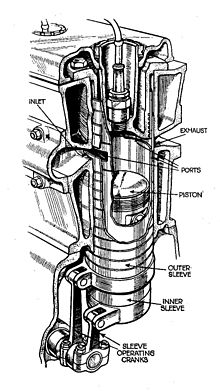Charles Yale Knight
Charles Yale Knight (* 1868 in Salem , Indiana , USA ; † 1940 ) became known as the inventor of the slide valve motor, which was named after him "Knight motor".
He was a journalist and printer and worked for the Minneapolis Tribune. In 1894 he moved to Chicago and founded "Dairy Produce" magazine.
The way to the valve motor
In 1901 he bought the 15th Waterless Knox as the first car , but was not satisfied with it because he found the air-cooled engine too loud. A few years later he bought a Searchmont , a car from a company that was already bankrupt at the time . He was particularly annoyed that the valve springs on his engine liked to break.
So Knight began researching a smoothly running internal combustion engine without the problems that lift valves cause. In doing so, he remembered his father's steam engine that drove his sawmill. He also wanted to use the sleeve valve to divert the steam for his new engine. His experiments were funded by the Chicago merchant Lyman Bernard Kilbourne. In 1904 he had developed a motor whose pistons were surrounded by two concentric, slotted sleeve valves, which were controlled by the eccentric shaft installed on the side so that they controlled the entry and exit of the combustion gases into the cylinders. The spark plugs were located in the centers of the hemispherical combustion chambers . All moving parts were oil-lubricated and all movements were smooth without jolts, which meant that the motor ran very quietly. In October the four-cylinder engine with a displacement of 2,523 cm³ was ready and installed in Knights Searchmont.
America's auto industry, however, was less interested in the new engine, since at that time the production of conventionally powered vehicles could hardly satisfy customer orders and therefore saw no reason to get involved in the new technology. Nevertheless, 38 Garford chassis could be equipped with the new type of engine by 1907 . These vehicles aroused great public astonishment because of their low level of driving noise: people said they rolled down the streets like rubber balls.
Daimler-Motoren-Gesellschaft in Stuttgart was one of the first people interested in obtaining a production license and then further developed the "Silent Knight". But Panhard & Levassor and Hotchkiss in France , Minerva in Belgium , Laurin & Klement in Austria-Hungary and other companies also manufactured these motors under license.
Web links and source
| personal data | |
|---|---|
| SURNAME | Knight, Charles Yale |
| BRIEF DESCRIPTION | American designer, inventor of the valve motor |
| DATE OF BIRTH | 1868 |
| PLACE OF BIRTH | Salem , Indiana , USA |
| DATE OF DEATH | 1940 |
